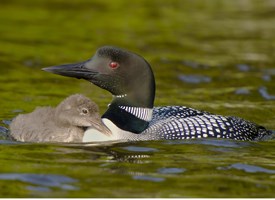
Call Sounds
http://www.allaboutbirds.org/guide/Common_Loon/sounds
Size & Shape
Common Loons are large, diving waterbirds with rounded heads and dagger-like bills. They have long bodies and short tails that are usually not visible. In flight, they look stretched out, with a long, flat body and long neck and bill. Their feet stick out beyond the tail (unlike ducks and cormorants), looking like wedges.
Color Pattern
In summer, adults have a black head and bill, a black-and-white spotted back, and a white breast. From September to March, adults are plain gray on the back and head with a white throat. The bill also fades to gray. Juveniles look similar, but with more pronounced scalloping on the back.
Behavior
Common Loons are stealthy divers, submerging without a splash to catch fish. Pairs and groups often call to each other at night. In flight, notice their shallow wingbeats and unwavering, bee-lined flight path.
Habitat
Common Loons breed on quiet, remote freshwater lakes of the northern U.S. and Canada, and they are sensitive to human disturbance. In winter and during migration, look for them on lakes, rivers, estuaries, and coastlines.
Cool Facts
The Common Loon swims underwater to catch fish, propelling itself with its feet. It swallows most of its prey underwater. The loon has sharp, rearward-pointing projections on the roof of its mouth and tongue that help it keep a firm hold on slippery fish.
Loons are water birds, only going ashore to mate and incubate eggs. Their legs are placed far back on their bodies, allowing efficient swimming but only awkward movement on land.
Loons are agile swimmers, but they move pretty fast in the air, too. Migrating loons have been clocked flying at speeds more than 70 mph.
A hungry loon family can put away a lot of fish. Biologists estimate that loon parents and their 2 chicks can eat about a half-ton of fish over a 15-week period.
Loons are like airplanes in that they need a runway for takeoff. In the case of loons, they need from 30 yards up to a quarter-mile (depending on the wind) for flapping their wings and running across the top of the water in order to gain enough speed for lift-off.
Loons are well equipped for their submarine maneuvers to catch fish. Unlike most birds, loons have solid bones that make them less buoyant and better at diving. They can quickly blow air out of their lungs and flatten their feathers to expel air within their plumage, so they can dive quickly and swim fast underwater. Once below the surface, the loonís heart slows down to conserve oxygen.
Like many young birds, juvenile loons are really on their own after mom and dad leave at about 12 weeks. The parents head off on migration in the fall, leaving juveniles to gather into flocks on northern lakes and make their own journey south a few weeks later. Once the juveniles reach coastal waters on the ocean, they stay there for the next two years. Finally in the third year, young loons return north for their first breeding season. Even though they havenít been home in awhile, young loons typically return to a lake within 10 miles of the lake where they were born.
Migrating Common Loons occasionally land on wet highways or parking lots, mistaking them for rivers and lakes. They become stranded without a considerable amount of open water for a long takeoff. A loon may also get stranded on a pond that is too small.
The Common Loon is flightless for a few weeks after molting all of its wing feathers at the same time in midwinter.
The oldest-known Common Loon lived at least 24 years, 1 month, spending its summers on a lake in Michigan.